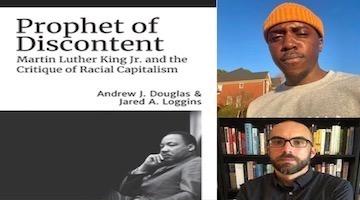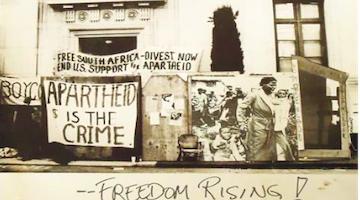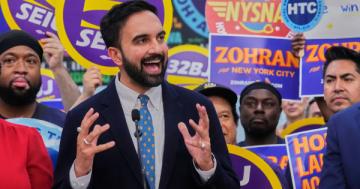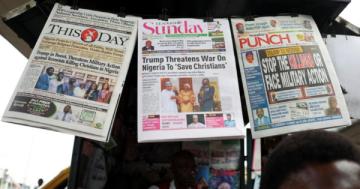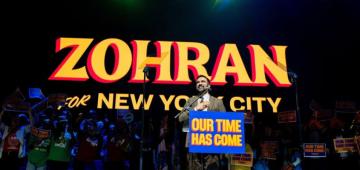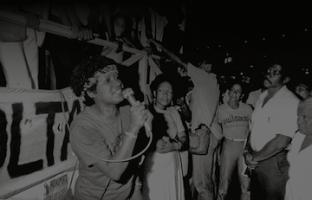The film is either “a meditation on a system of justice that treats innocent people as outlaws,” or “a bourgeois representation of the struggle against police oppression.”
The Problem With Queen & Slim
by Enzo Calandra
“After the death (of great revolutionaries), attempts are made to convert them into harmless icons, to canonize them, so to say, and to hallow their names to a certain extent for the “consolation” of the oppressed classes and with the object of duping the latter, while at the same time robbing revolutionary theory of its substance, blunting its revolutionary edge and vulgarizing it.” – V.I. Lenin
Queen & Slim, the debut film from screenwriter Lena Waithe and director Melina Matsoukas, betrays its potentially revolutionary subject matter and instead delivers a predictable, uninspired, and fatalistic melodrama. The film is a bourgeois representation of the struggle against police oppression which portrays police violence as an immutable and unchangeable reality. Queen evokes past revolutionaries’ successful plights against the police (figures such as Assata Shakur and Huey P. Newton who have either evaded capture or taken their case to trial and won) yet vulgarizes their legacies, extinguishing the audience’s hope in the potential for victory against the police apparatus.
The film begins with a gripping and realistic depiction of police brutality in which Queen is shot and Slim retaliates, killing a police officer and forcing the two to go on the run. In contrast to the opening scene, however, their escape slips further and further from social realism and begins to feel more like a road trip flick, as the gravity of their situation is lost between nights dancing, riding horses, and saccharine romance. The separation of the film from the real world in the name of “style” reaches its peak when Queen and Slim don “sexy” outfits acquired from one of their many supporters and a teal muscle car: a painfully obvious reach for “style” which defies all reason and reality. Waithe calls her film a “rebel cry” and “revolutionary.” How is Queen supposed to provoke a revolutionary transformation when it fails to even establish a basis of social realism on which the revolutionary subject is to act?
“Their escape slips further and further from social realism and begins to feel more like a road trip flick.”
Comments by Waithe during the press run for Queen demonstrate the liberal one-dimensionality of the film’s message:
“But we had a black man run this country, and we still have yet to have a black man run a major studio. That tells you a lot about where we’re at as an industry, we’re still trying to play catch-up… And don’t get me started on black financiers! How many of those do we have?”
To Waithe, the capitalist studio system does not require dismantling; she has no desire to wrestle the control of the cinematic means of production and put them in the hands of working class communities. As evidenced by the above comments, Waithe is content with pursuing shallow identity politics which do not alter social and economic relations of power, lamenting the lack of black studio heads and financiers as if their class interests are irrelevant and would not ideologically affect their output. This myopic, essentializing way of thinking is clearly central to Waithe’s worldview. According to Waithe, because director Matsoukas is Black, Greek, and Cuban, she is inherently a superior director:
“I don’t think I could be the director that Melina is. She’s a combination of so many things – even racially, the fact that she’s black, she’s Greek, she’s Cuban. All of those things make her such a specific storyteller.”
Waithe’s liberal perspective is perceptible in the film, as all black cops are portrayed as sympathetic to the cause of black liberation even though a thorough analysis of US settler society reveals all police to be systemically and inextricably opposed to it. The reality of the systemic role of police as chief instruments of state power and foot soldiers of capital is masked in the film by focusing on the individual good intentions of one or a few cops. Just as she portrays black cops as benevolent because she is not meaningfully opposed to capitalist exploitation and colonial-style oppression, Waithe wishes for more black studio heads and financiers as she is not meaningfully opposed to the capitalist studio system which stifles artistry and the ability of people to portray their own realities through film. As Adorno and Horkhiemer brilliantly state in The Culture Industry, “…when directors’ incomes are published, any doubt about the social utility of the finished products is removed.”
“The reality of the systemic role of police as chief instruments of state power and foot soldiers of capital is masked in the film.”
The most egregious aspect of the movie is the threadbare protest sequence in which an implicitly sympathetic black police officer is gunned down by a young child inspired by Queen and Slim’s exploits. By having the black officer remove his riot gear and talk to the young man as his equal, we are led to believe that he is “one of the good police” whose death is brought about more by adolescent, rather than righteous, rage. But does this correspond to our social reality? Are we not supposed to sympathize with the young boy, as the film suggests we shouldn’t? Is violence against police unjustified given countless documented murders and centuries of colonial-style oppression? The film lacks courage and fails to come down on one or another side of these questions. Even more tone deaf is the intersplicing of the protest violence with the two leads making love in the car—juxtaposed to say… what exactly? I doubt even Waithe and Matsoukas could offer an explanation which justifies such a provocative decision beyond a cliché regarding the polarity of love and anger.
Queen & Slim relegates resistance to police brutality to the realm of fantasy through nauseating melodrama and contrived style, failing to represent the world as it is and to encourage the viewer to self consciously act upon it. At the end of the film, Queen and Slim are immortalized as wheatpaste graffiti on the side of a building. Much like what Queen & Slim has done to the legacies of black revolutionaries, the titular characters have been reduced to the level of image and stylized spectacle in what is supposed to have been an “empowering” gesture.
The Powerful Perspective of “Queen & Slim”
by Jelani Cobb
“Queen & Slim is a meditation on a system of justice that treats innocent people as outlaws.”
The story of “Queen & Slim” is propelled by an arbitrary traffic stop, in which a police officer detains a couple on a first date, played by Daniel Kaluuya and Jodie Turner-Smith.
Last October, five days after the former police officer Amber Guyger was sentenced in the fatal shooting of Botham Jean, an unarmed twenty-six-year-old black man, whom she shot in his home, and five days before Atatiana Jefferson, a twenty-eight-year-old black woman, was killed in her home by the police officer Aaron Dean, “Queen & Slim” began previews in a small theatre just off Bryant Park. The film is the product of the vision of two black women: Lena Waithe, who wrote it, and Melina Matsoukas, who directed it. (Waithe and James Frey, the famed memoirist, collaborated on the story.) It means something that a movie that was conceived years ago could land so squarely in the midst of dual tempests involving firearms, police, and black people whose lives expired violently, prematurely, at the hands of white people who were sworn to protect them. The fact that both Jean and Jefferson were at home when they were killed underscores a central conceit of the film: that a system capable of dispensing such arbitrary deaths cannot be trusted in any context, least of all to administer justice on behalf of those whom it also victimizes.
The recognition of this fact changes the implications of the story that Waithe and Matsoukas tell with this film: about a couple on a first date who kill a police officer in self-defense, and their subsequent life as fugitives. Early buzz around the movie pegged it as a “Bonnie and Clyde” tale for the Black Lives Matter set, but that would be an entirely different film from “Queen & Slim.” “Bonnie and Clyde” is the story of two outlaws who are fleeing justice; “Queen & Slim” is a meditation on a system of justice that treats innocent people as outlaws. This is not a novel undertaking. It’s hard to overlook, for instance, that this movie arrives in theatres in the same year as the thirtieth anniversary of Spike Lee’s “Do The Right Thing.”
Jelani Cobb is a staff writer at The New Yorker and the author of “The Substance of Hope: Barack Obama and the Paradox of Progress.”
This article previously appeared in The New Yorker.
COMMENTS?
Please join the conversation on Black Agenda Report's Facebook page at http://facebook.com/blackagendareport
Or, you can comment by emailing us at comments@blackagendareport.com





